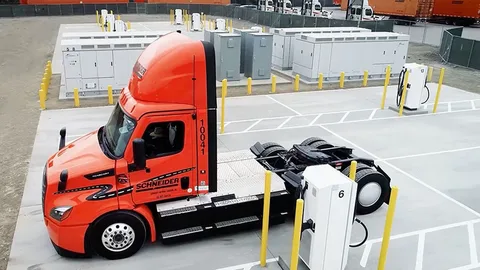From Pilots to Portfolios: Scaling CV Depot Charging

Introduction
The CV Depot Charging Market is expanding rapidly as commercial fleets electrify to reduce operating costs, comply with emissions regulations, and meet corporate sustainability goals. Depot charging refers to centralized charging infrastructure installed at fleet depots, distribution centers, bus yards, and logistics hubs where vehicles dwell predictably—typically overnight or during scheduled breaks. Unlike public fast-charging focused on drivers in transit, depot solutions prioritize cost per kWh, load management, uptime, and integration with fleet operations. As battery-electric trucks, delivery vans, refuse haulers, and transit buses scale, operators are rethinking energy procurement, power capacity, and yard workflows. The market now spans AC charging for light commercial vehicles (LCVs), high-power DC charging for medium- and heavy-duty vehicles (MHDV), software-defined energy management, onsite generation and storage, and turnkey EPC + O&M services. With total cost of ownership (TCO) gains and maturing technology, depot charging is becoming the backbone of commercial fleet electrification.
Market Drivers
Regulatory pressure and corporate decarbonization targets are the strongest catalysts. Low-emission zones, zero-emission purchase incentives, and impending tailpipe standards push operators toward battery-electric fleets. Predictable duty cycles—return-to-base routes for parcel delivery, municipal services, and transit—fit depot charging well, allowing overnight slow-to-mid-rate charging that minimizes energy costs. Electricity is typically cheaper and more stable than diesel on a per-mile basis, and managed charging aligns vehicle charging with off-peak tariffs or demand-response programs to reduce utility bills. Battery and charger improvements—higher charge rates, better thermal management, and standardized connectors—boost fleet uptime. Finally, data-rich telematics and charging management platforms optimize dwell time, charger assignment, and state-of-charge targets, improving asset utilization.
Market Challenges
Power availability and grid interconnection timelines remain key barriers. Many depots lack sufficient electrical capacity for large MHDV fleets, necessitating costly service upgrades, switchgear, and utility-side reinforcement. Long lead times for transformers and interconnects can outlast vehicle delivery schedules, risking stranded assets. Demand charges and peak loads can erode TCO without robust load management and staged fleet ramp-up. Site complexity—limited space for chargers, cable routing, and safe vehicle circulation—requires careful yard design. Multi-vendor interoperability challenges can arise across chargers, vehicles, and software, complicating operations. For heavy-duty use cases with tight turnarounds, charge rates needed to hit duty cycles may push infrastructure toward megawatt-class systems, increasing cost and engineering complexity. Finally, change management—training technicians and drivers, updating SOPs, and aligning maintenance—can slow deployment.
Market Opportunities
Smart energy ecosystems at depots unlock major value. Energy management systems (EMS) with dynamic load control, tariff optimization, and vehicle-priority logic can shift charging to low-cost periods and cap peaks. Adding onsite solar PV and battery energy storage systems (BESS) provides resilience, shaves demand charges, and supports grid services revenue. Fleet-time-of-use strategies—opportunistic top-ups during lunch or between shifts—reduce required peak power and right-size infrastructure. Modular, skid-mounted DC chargers, switchgear, and pre-wired raceways accelerate buildouts and simplify future expansion. For high-throughput hubs, high-power DC (350–500 kW) and in future MCS (Megawatt Charging System) will serve tractors and coaches, while AC or low-power DC efficiently handles vans. Turnkey delivery models—design–build–finance–operate (DBFO) or charging-as-a-service—lower capex and execution risk. Data services—predictive maintenance, charger health scoring, and battery analytics—create ongoing value for operators and financiers.
Regional Insights
Mature EV markets prioritize depot strategies tied to dense logistics corridors. Urban regions with emissions regulations and robust incentives see rapid adoption in parcel, grocery, and municipal fleets. Transit agencies lead in heavy-duty depot charging with standardized hardware, redundancy, and depot microgrids for resilience. Industrial zones near ports and railheads are piloting yard tractors and drayage trucks with high-power DC to meet air-quality goals. Suburban and rural depots focus on cost-optimized AC/DC blends and staged grid upgrades aligned to vehicle procurement cycles. Cold or hot climates drive investment in preconditioning, weather-hardened enclosures, and heated cable solutions to maintain charge rates and battery health.
Future Outlook
The CV Depot Charging Market will evolve toward integrated, software-defined energy hubs. Expect widespread adoption of ISO 15118 features (plug-and-charge, smart charging), OCPI/OCPP-based interoperability, and fleet orchestration that blends charger control with dispatch and maintenance. Load management will become predictive, using route plans, traffic, and weather to set charge targets and avoid peaks. MCS will unlock sub-30-minute turnarounds for long-haul tractors and high-utilization coaches, while inductive or automated pantograph solutions appear in high-frequency bus and yard applications. Depots will increasingly pair PV + BESS with flexible tariffs and participate in demand response and capacity markets, turning charging from a cost center into a controllable asset. Hardware will standardize around modular power blocks and liquid-cooled dispensers to simplify service and scaling. By late decade, digital twins of depots will simulate expansion phases, grid constraints, and TCO, guiding investment. Circularity—second-life batteries for depot storage and recyclable cabling—will round out sustainability goals.
Conclusion
Depot charging is the operational anchor of commercial fleet electrification. While grid capacity, permitting timelines, and site constraints create friction, the combination of managed charging, modular high-power DC, and onsite energy resources delivers compelling TCO and reliability. Operators that treat depots as energy systems—integrating software, hardware, and utility strategy—will realize superior uptime and cost control. Vendors offering interoperable chargers, robust EMS, and turnkey project delivery will lead the market. As standards mature and megawatt-class solutions arrive, depot charging will scale from pilot yards to enterprise-wide networks, enabling zero-emission logistics, transit, and municipal services at pace.


